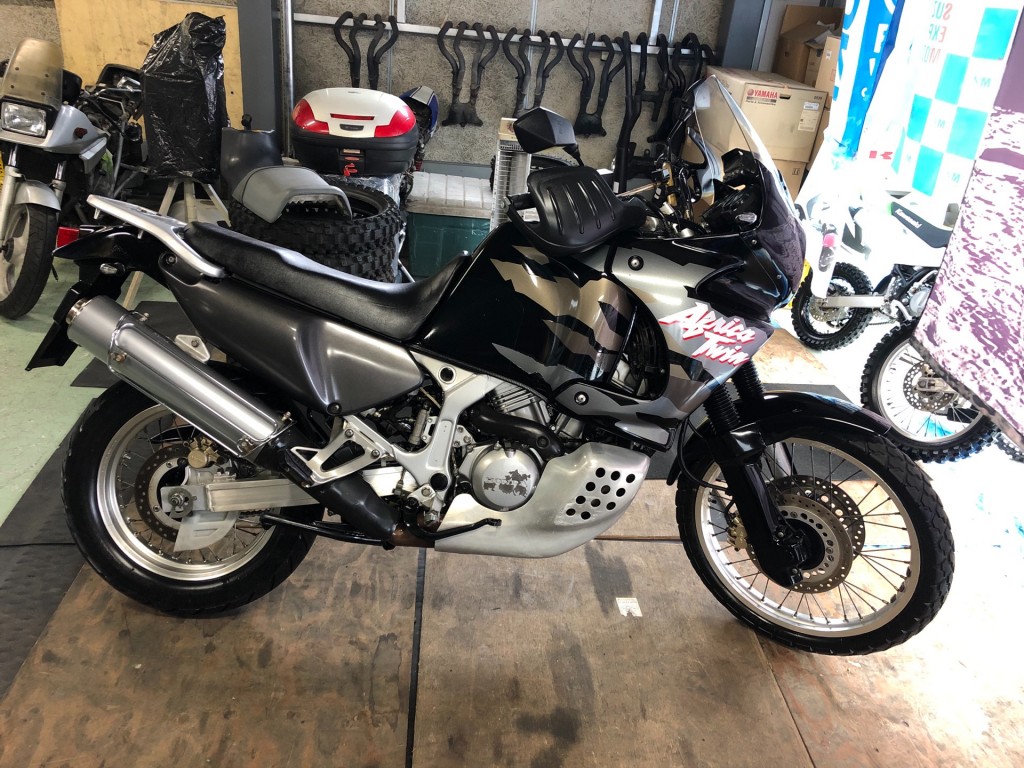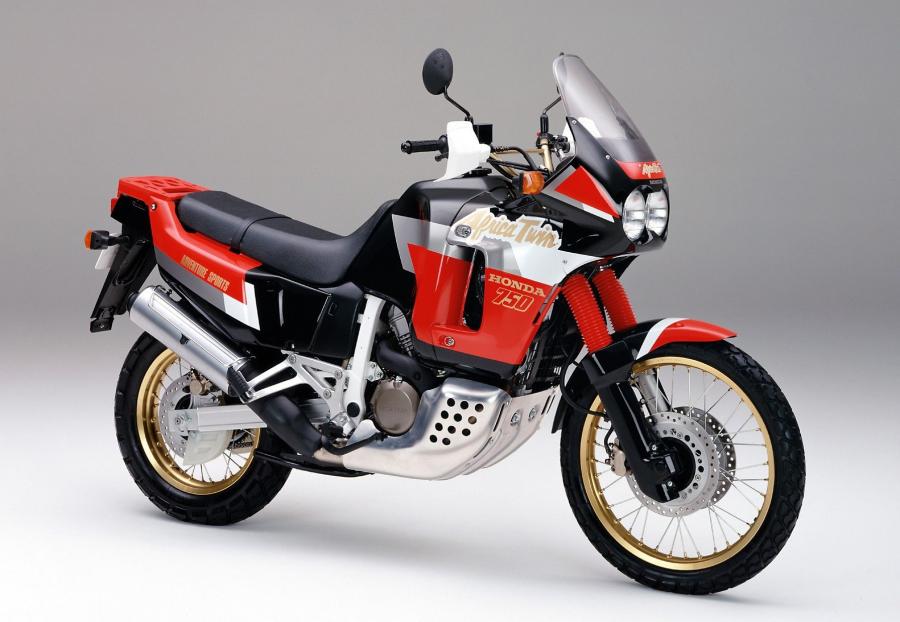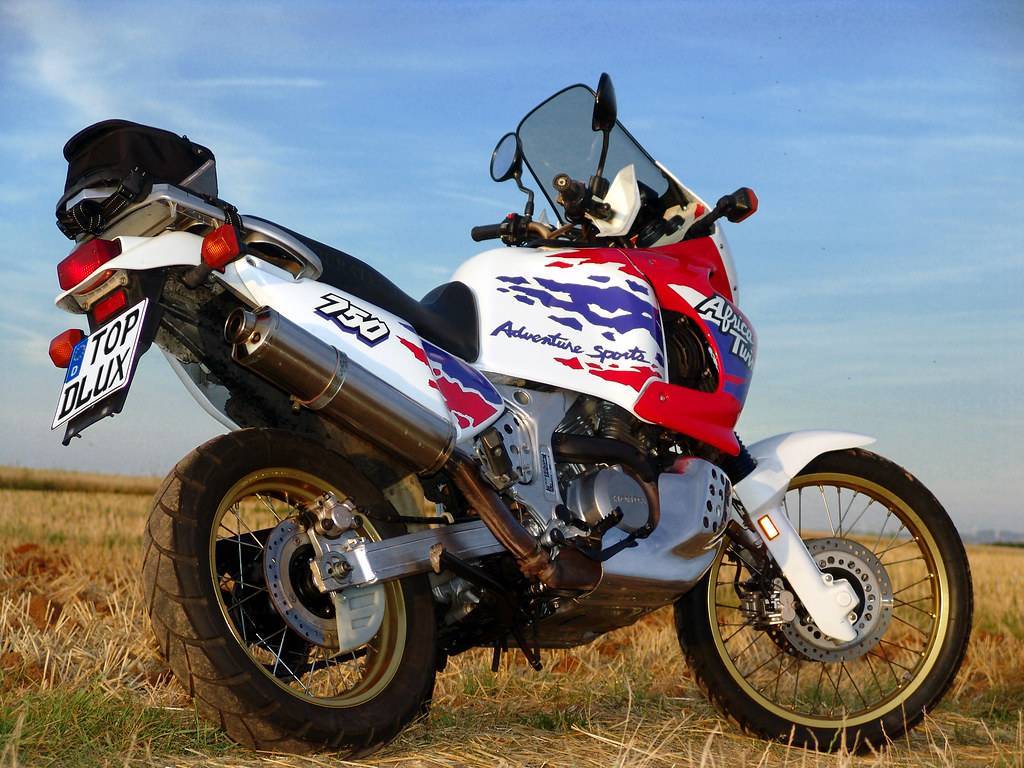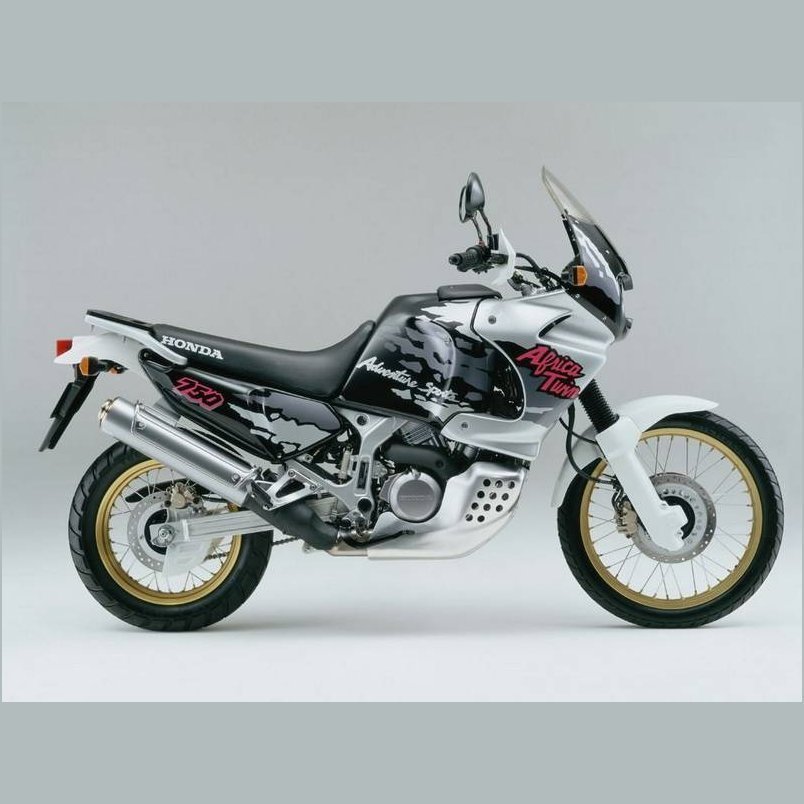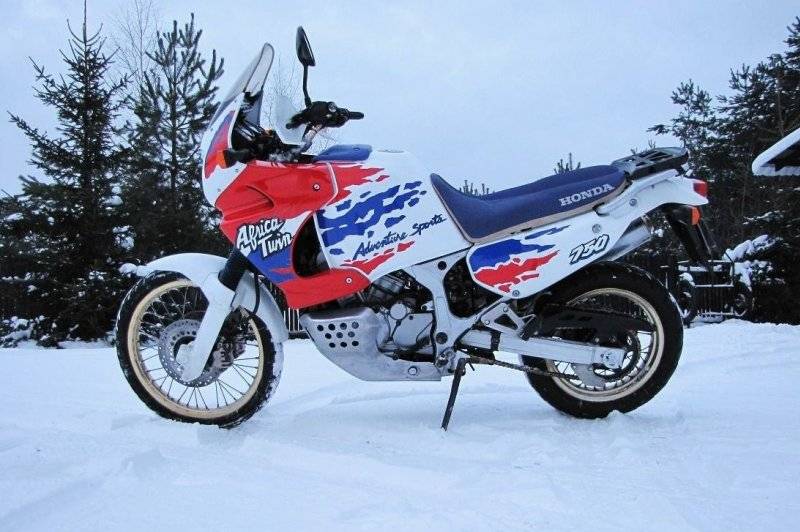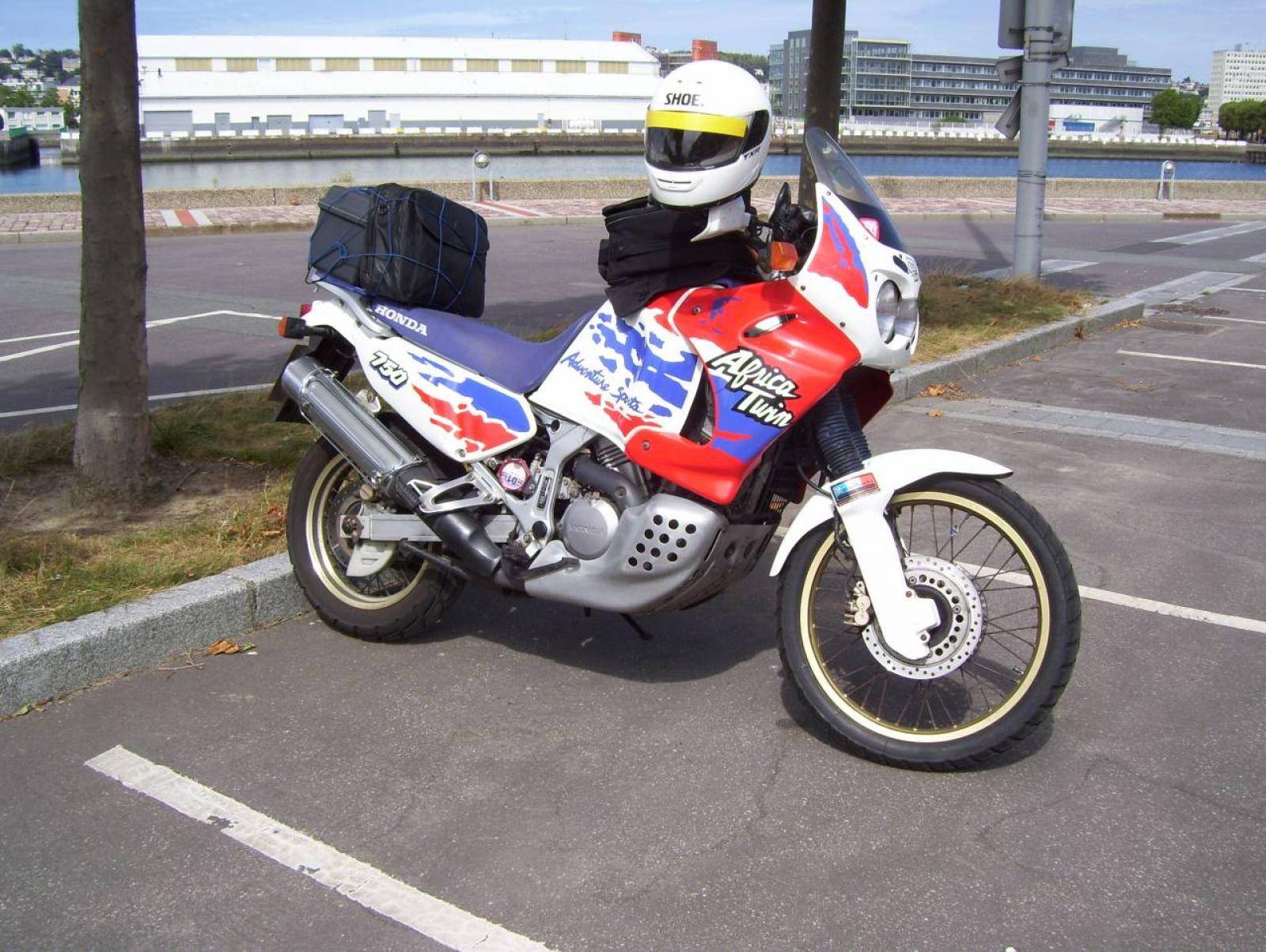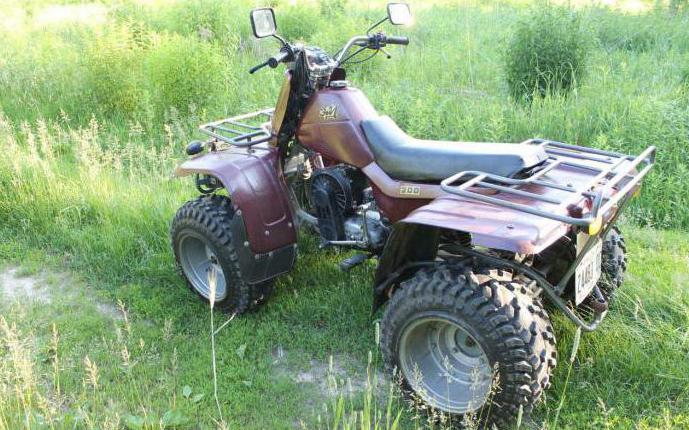Power Play
What is evident on this bike is that it’s all about the torque. You get the best from the motor running somewhere between 3,000-5,000rpm and using every one of that 62Nm of grunt to waft you through the landscape. Honda quoted a top speed of just over 115mph, but you’d have to be a brave soldier to try that back in 1998, let alone some 22 years later. But with the A46 calling for nothing more enthusiastic than the national speed limit, being on the saddle of the old Africa Twin feels like a great place to be on a crisp autumn day.
THE BIKE
Our test bike is a 1998 Honda XRV750 Africa Twin RD07P model. Keen-eyed readers will spot that it has a kilometre speedo, and this is because it’s originally from Germany. Owner Will is a bit of an entrepreneur, and a few years back, prices for Africa Twins in the country were lower than in the UK.
Armed with a fistful of Euros, he went on a buying trip, coming back with four similar aged XRVs and even a super rare XLV750R, the aborted model from before the first Africa Twin. Selling four of the bikes left him one for himself, paid for with the profits. Genius.
Will’s bike is still largely stock, save for Touratech handguards, crash bars, a rear rack, and as few other adventure riding farkles.
If you fancy bagging a classic Africa Twin for yourself, the Chequered Flag Cafe, in Cornwall, has a showroom with a selection of the bikes in stock.
That’s not all either. Alongside its impressive collection of vintage adventure bikes, there’s a café with plenty of options for a mid-rideout breakfast or lunch, and an on-site workshop where you can rent specialist tools or even enlist the help of the resident mechanic to work on your bike.
To find out more visit www.chequeredflagmotorcycles.com.
Upfront there are twin 276mm discs with a pair of twin pot callipers, and at the rear, there’s a single pot calliper and a 256mm disc. It’s pretty much state of the art for this age of bike.
OK, so they don’t boast the phenomenal stopping power of the 2021 motorcycle’s four-pot, ABS assisted, radially- mounted callipers on a set of discs some 34mm larger, but in fairness, the old bike’s anchors are still good enough for everything from smooth braking right up to eyeballs-on-the-visor stopping moments.
The rear brake on both bikes is interestingly still largely unchanged, the modern-day machine having an identical sized disc and single pot unit to get the job done efficiently and smoothly. As a guy that uses the rear brake a lot, I like that.
What is perhaps more of an achievement is how the 1998 Africa Twin manages this efficient and unruffled braking with forks that, by today’s standards, look as thin as pipe cleaners. Honestly, there are kid’s mountain bikes in Halfords with wider forks than a vintage Africa Twin.
However, the 43mm air-assisted forks are surprisingly competent on the road, and according to owner Will, for fairly spirited off-road shenanigans from gnarly country lanes to abandoned military roads in the Alps.
Yes, if you go full Dakar on the 1998 bike then things will get squirrelly pretty quickly, but this is a cunningly simple self-limitation process. If the bike is beginning to get out of shape and panicky, then you are going too fast. Old school technology relies far more on the rider than today’s preference for electronic rider aids to keep you upright.
There is still 220 mm of travel in the front fork, which is only a centimetre less than the 2021 bike, and at the rear, the centrally mounted shock delivers a respectable 214 mm of movement, which is just 6mm off the modern incarnation. The shock is adjustable for preload and compression damping, but for this, it’s a case of reaching for the C-spanner and screwdrivers rather than pressing a button on the bars. That’ll please the Luddites out there.
Comfort over distance and touring
Late 1980s/early ‘90s Dakar replicas were ahead of their time in terms of paving the way for today’s adventure bikes which have proved so popular, partly for their long distance comfort and touring ability, and the 750 Africa Twin was undoubtedly one of the most comfortable and touring-friendly of the bunch – hence its continuing popularity today. Although the seat is fairly narrow it’s decently comfortable, especially on the later models. The ride is plush; its big tank is good for 200 miles and the fairing gives reasonable weather protection, too. The restyled1993 RD07 was a significant step up from the 1990 RD04 original, in this respect, while the 1996-on RD07A is better still thanks to a new seat and taller screen.
Present And Correct
Fast forward to England in November 2020, the day before the second coronavirus-inspired national lockdown ground the country to a halt, and our test bike is wheeled out of Will’s van into the ABR car park on a sparkling autumn morning. The bike is a 1998 RD07P model and, although five years on from the upgrade in 1993, it’s not visually that much different.
The massive 23l tank bulges towards the front of the bike and there’s that iconic ‘90s twin headlight fairing with its stubby screen. Below the screen is the one-piece look of the front mudguard and fork protectors, while at the back, the chunky original end can follow the line of the side panels to the surprisingly minimal back end. Jeez, it’s a good-looking bike.
With the photos and general faffing out of the way, I get the chance to actually put some distance on the bike and form a true impression of how it rides and stacks up to the 2021 Africa Twin Adventure Sports incarnation, currently in the ABR long-term fleet. Straight away, the wide bars and lack of clutter in the refreshingly open cockpit is a stark contrast to today’s machines. My classic bike’s limited number of buttons and lack of a TFT display look positively minimal. Looking for the traction control? That’ll be your right wrist.
First Edition
SPECS AT A GLANCE
PRICE: From around £4,000 depending on conditionENGINE: 52-degree, liquid cooled V-twin, with SOHC and three valves per cylinderCAPACITY: 742 ccGEARBOX: Five speed with chain transmissionPOWER: 61bhp @ 7,500rpmTORQUE: 62Nm @ 6,500rpmSUSPENSION: Front: 43mm air-assisted telescopic fork, conventional orientation, not USD. Rear: Centrally mounted rear shock with Pro Link, adjustable for preload and compression dampingBRAKES FRONT: Twin 276mm discs with two-piston callipers. Rear: Single 256mm disc and one-piston calliperWEIGHT: 207kg (dry)TANK CAPACITY: 23lSEAT HEIGHT: 860mm
Even before the NXR750 had taken its fourth and, as it turned out, final win at the infamous event, Honda had realised the commercial potential of their machine, and indeed the adventure styling of the bike. BMW had already launched and had showroom success with its fledgling GS range following their own successes in the Paris Dakar, and for Honda, the path forward was clear.
In 1988, the first Africa Twin was released to an eager motorcycle market, fitted with a slightly smaller 650cc V-twin engine, but crucially, bristling with all the design cues, off-road prowess, and hutzpah of Neveu’s race-winning machine.
Even by today’s standards, the original Africa Twin is a fantastic looking machine, and if you’ve got one, then it’s going to go up in value on a daily basis. And perhaps more importantly, it’s cooler than a penguin’s instep.
Buoyed by the success of the first incarnation, in 1990 Honda upped the capacity by 100cc to match the original NXR750 and, although the bike had a raft of improvements and refinements, Honda didn’t mess with the rugged look and killer stance of the Africa Twin.
Three years later, the third and, as it turned out, a final major redesign of the XRV750 gave it a new frame and a wider, taller profile. It was a calculated response to the bikes increasing popularity with buyers who wanted to indulge in touring across the world, clearly loving the Africa Twin’s continent-crossing prowess.
But for all this success through the mid-’90s, the popularity of the adventure bike gradually waned as we headed for the new millennium and, perhaps seeing the bike as the past rather than the future, Honda finally ceased production of the model in 2001. After 73,000 bikes sold, the once all-conquering XRV slipped gently into the back catalogue, apparently consigned to the history books.
 The slim front tyre gives good grip and feel
The slim front tyre gives good grip and feel A wide seat provides all day comfort
A wide seat provides all day comfort Our test bike’s stock exhaust
Our test bike’s stock exhaust No TFT display here
No TFT display here
Ссылки
- ^ Кох, Вернер (21 февраля 2013 г.). «Auf Achse: Honda XRV 650 Africa Twin» . Моторрад Классик . Проверено 9 марта 2017 г. .
- Suesse , Нед (18 декабря 2015 г.). «Honda Africa Twin 2016 — ОБЗОР ПЕРВОЙ ПОЕЗДКИ» . Циклический мир . Проверено 21 марта 2016 г. .
- ↑ Хеннинг, Ари (15 декабря 2015 г.). «Первая поездка: Honda CRF1000L Africa Twin 2016 г.» . Мотоциклист . Проверено 22 марта 2016 г.
- ^ Билер, Дженсен (ноябрь 2014 г.), «Вблизи с прототипом Honda« True Adventure »» , « Асфальт и резина » , получено 12 ноября 2014 г.
- Коннор, Уильям (ноябрь 2014 г.), «Новый африканский близнец? Honda True Adventure» , Ride Apart , получено 12 ноября 2014 г.
- Макдональд, Шон (декабрь 2015 г.), «Обзор поездки: Honda Africa Twin 2016 г. – это именно то, чего мы ждали» , Lanesplitter , получено 13 февраля 2016 г.
- Чанг, Деннис (июнь 2014 г.), «Ретро-стиль Dual Sport раскрыт в заявке на патент Honda» , Motorcycle.com , получено 12 ноября 2014 г.
- Силер, Уэс (июнь 2014 г.), «Как новая воздушная коробка Honda обеспечит эргономику африканского байка-внедорожника» , Gizmodo InfinitelyWild , получено 12 ноября 2014 г.
- Дабни, Роб (ноябрь 2014 г.), «Новый Honda Africa Twin наконец-то представлен на EICMA» , ADV Pulse , получено 12 ноября 2014 г.
- «Honda True Adventure Episode 1 The Dream» , Я бы лучше поехал , ноябрь 2014 г. , получено 12 ноября 2014 г.
- GridOto.com. «Тест-драйв Honda CRF1000L Africa Twin DCT, Main Tanah Tanpa Gigi Asyik Juga! — Семуа Халаман — GridOto.com» . gridoto.com .
- “Поездка через три десятилетия истории африканских близнецов” . 28 октября 2020 г.
- «Обзор Honda Africa Twin и Africa Twin Adventure Sports ES 2020 года» .
- “Обновление Honda Africa Twin” .
Individual evidence
- ↑
- ↑
- Rolf Henniges: (No longer available online.) In: Motorrad , issue 25/2003. November 9, 2003, archived from the on August 24, 2013 ; Retrieved September 17, 2013 . Info: The archive link was inserted automatically and has not yet been checked. Please check the original and archive link according to the instructions and then remove this notice.
- ↑
- Fred Siemer: (PDF; 3.5 MB) In: Motorrad . Edition 9/1988. September 1, 1988, accessed February 22, 2015 (pp. 84–90).
- Michael Pfeiffer: 2 wheels . No.4, 2009, S.51.
- Alan Dowds: Motorcycles – The World’s Breathtaking Superbikes. Amber Books Ltd., 2004, ISBN 3-89736-329-1 , p. 169.
- ↑ Klaus Herder: (No longer available online.) In: bma. Edition 11/1998. July 23, 2008, archived from the on March 14, 2013 ; accessed on May 6, 2018 .
- Thomas Delekat: In: The world . July 27, 2015, accessed August 14, 2015 .
HONDA XRV750 AFRICA TWIN (1990-2003) Price
Now considered something of a modern classic, prices of good 750 Africa Twins, partly because of their proven high mileage reliability and quality compared to rivals of the time, are on the up and easily exceed those of the contemporary Yamaha Super Ténéré, Suzuki DR800 and so on. The best, and most expensive are the last, post-1993 RD07 version with curvier bodywork and 1996-on RD07A with taller screen and improved seat. Expect to pay £4-5K for a clean example with 35K on the clock. Purists, however, may prefer the more angular RD04 (1990-93) which doesn’t seem to wear as well so can be had for £2750-£3500. While the very first 650 RD03, which is rarest of all as wasn’t officially exported into the UK, is smaller, lighter and has just 57bhp and a single disc, is prized for its rarity, quality HRC-built features and originality. Reckon on around £3K – if you can find one.
Model variants of the XRV 750
RD04 from 1990 to 1992
Tripmaster above the speedometer
In 1990 the displacement of the successor model RD 04 was increased from 647 to 742 cm³, whereby the output rose from 57 to 59 hp. Due to changed timing, a larger carburetor cross-section and a compression reduction from 9.4 to 9.0, the maximum torque increased from 55 to 61 Nm. Honda wanted to improve stability with a stronger clutch, larger connecting rod and crankshaft bearings and a higher flow rate from the oil and water pump . Compared to the previous model, the RD 04 had an oil cooler , a reinforced frame with a swing arm extended by 5 mm, a modified fairing, and a double disc brake systemand from 1992 a digital trip meter called Tripmaster. The larger engine and the upgrade increased the weight from 220 to 238 kg, but the top speed also increased from 165 to 174 km / h.
RD 07 from 1993 to 1995
The Africa Twin was extensively revised in 1993 and also offered in a dethrottled version with 44 kW (60 PS). Thanks to the new flat slide carburetors, the nominal power increased by 10 HP. The air filter is mounted above the carburetor in order to suck in less dust thrown up by the front wheel, which also increases the fording depthelevated. The modified double-loop tubular frame was 4 kg lighter. A shortened rear swing arm reduced the seat height from 88 to 86 cm. The front and rear brake calipers have been modified to make it easier to replace the brake pads. A tank reduced to 23 liters reduced the total weight to 230 kg and the range to 300 km with an average fuel consumption of 6.2 liters of regular gasoline per 100 km.
Overall, the RD 07 was more suitable for touring than its predecessors, but not more sporty.
RD 07a from 1996 to 2000
The RD 07a is the last evolutionary stage of the Africa Twin, which was manufactured until production was stopped in 2000. The former two pulse generator and ignition coils have been replaced by one each, which supplies both spark plugs with voltage. The gold anodized rims, the air support of the telescopic fork and the adjusting screw for the compression damping were omitted compared to the RD 07.
The models sold from 2001 to 2003 were assembled or sold from stock. Honda had sold a total of 72,091 units in Europe by the end of 2003, including 20,823 in Germany.
Model comparison
| Model code | RD03 | RD04 | RD07 | RD07a |
|---|---|---|---|---|
| Sales description | XRV 650 | XRV 750 | ||
| model | J to K | L to N | P to S | T to Y |
| Construction year | 1988–1989 | 1990–1992 | 1993–1995 | 1996–2000 |
| rated capacity | 37 kW (50 PS) | 44 kW (60 PS) | ||
| overall length | 2295 mm | 2330 mm | 2380 mm | |
| width | 895 mm | |||
| height | 1290 mm | 1420 mm | 1430 mm | |
| wheelbase | 1564 mm | 1565 mm | 1564 mm | |
| Seat height | 890 mm | 860 mm | ||
| Dry weight | 187 kg | 210 kg | 205 kg | |
| Tank volume (with reserve) | 24 Liter | 23 Liter |
Model succession
The successor model XRV 850 with an output of 59 kW (80 PS), discussed in the press, was not realized by Honda, instead the much more powerful and approx. 40 kg heavier Honda XL 1000 V Varadero appeared in 1999 . At EICMA 2014, the prototype of the Honda CRF 1000 L True Adventure was presented, which was positioned by Honda as the successor to the NXR 750 V and came onto the market in 2015 as the Honda CRF 1000 L Africa Twin .


